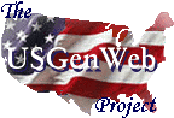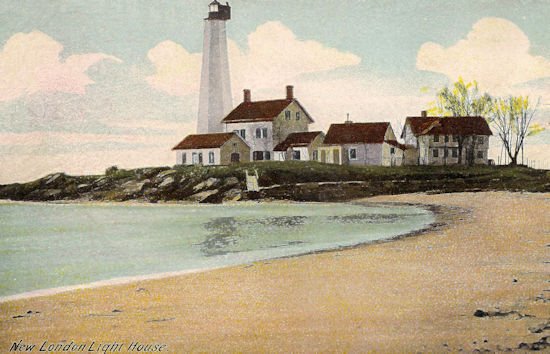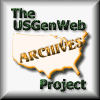 Before the
Dutch and the English settlers, the area now known
as New London County was inhabited by several
Indian tribes. The Pequot had migrated from the
Hudson river region and inhabited the land between
the Thames and Pawcatuck Rivers. The
Mohegan tribe was split after a war with the
Pequot in the 1630s, and the Uncas moved farther
northwest. The Western Nehantics
(Niantics) were centered around Lyme and
Waterford, and the Narragansett tribe was located
east of the Pawcatuck River.
Before the
Dutch and the English settlers, the area now known
as New London County was inhabited by several
Indian tribes. The Pequot had migrated from the
Hudson river region and inhabited the land between
the Thames and Pawcatuck Rivers. The
Mohegan tribe was split after a war with the
Pequot in the 1630s, and the Uncas moved farther
northwest. The Western Nehantics
(Niantics) were centered around Lyme and
Waterford, and the Narragansett tribe was located
east of the Pawcatuck River.
The
Pequot was the dominant tribe and, in 1632
drove the Narragansetts ten miles beyond the
Pawcatuck river, initiating a border dispute
between Connecticut and Rhode Island that would
last for many years to come.The Dutch fort and
trading post where Hartford now stands had
negotiated a satisfactory agreement with the
Pequot and expected to continue its hunting and
trade business in that area peacefully, but in
1633 the Pequots attacked a group of English
traders, and relations began to change.
 The parent colonies of Connecticut were
the Plymouth and Massachusetts Bay Colonies.
In 1636 an expedition led by the Reverend Thomas
Hooker became the first permanent settlement in
Connecticut. The first white child born in
Connecticut was David Gardiner, son of Lion
Gardiner, born April 29, 1636 in Saybrook.
The parent colonies of Connecticut were
the Plymouth and Massachusetts Bay Colonies.
In 1636 an expedition led by the Reverend Thomas
Hooker became the first permanent settlement in
Connecticut. The first white child born in
Connecticut was David Gardiner, son of Lion
Gardiner, born April 29, 1636 in Saybrook.
Feeling
that
it was time for strong action, the General Court
in Hartford ordered an offensive war against the
Pequot, and two parties were mobilized under Capt.
John Mason, with Capt. Underhill. The result
was the attack of the Pequot fort on the west side
of the Mystic River, and the massacre of over 700
Pequot men, women and children.
 In 1640/41 the
General Court surveyed and divided the Pequot
Country among Captain John Mason and the soldiers
who had served with him, but it was several more
years before there was a permanent settlement in
what is now New London County.
In 1640/41 the
General Court surveyed and divided the Pequot
Country among Captain John Mason and the soldiers
who had served with him, but it was several more
years before there was a permanent settlement in
what is now New London County.
William
Chesebrough from Rehoboth, MA was the first
actual settler of New London in 1649,
followed immediately by Thomas Stanton of
Hartford, Indian interpreter, and in the next ten
years by the families of: Walter
Palmer, George Denison, Thomas Miner; James
Avery, Johnathan Brewster, The Rev.
Richard Blinman, John Picket, Lion
Gardiner, John Hayes, Robert
Hempstead, John Gallup, John Stebbins,
John Winthrop, Peter Harris,
John Chennery, Cary Latham, Robert and
Thomas Park(e), Obadiah Bruen, James
Rogers, Thomas Hewitt, Matthew Griswold and
others.
 The settlements enjoyed a
period of growth and development for the next
decade, until the 1660s when threats from the
surrounding Indian tribes began to grow. War
finally erupted June 1675 in Swansea,
Massachusetts with "King Philip", second son of
Massasoit, sachem of the Pokanoket
Indians. In the beginning
Connecticut felt secure in its geographical
location and longstanding alliance with the local
Mohegans...then followed several years of brutal
attacks and a reign of terror against the English
settlements.
The settlements enjoyed a
period of growth and development for the next
decade, until the 1660s when threats from the
surrounding Indian tribes began to grow. War
finally erupted June 1675 in Swansea,
Massachusetts with "King Philip", second son of
Massasoit, sachem of the Pokanoket
Indians. In the beginning
Connecticut felt secure in its geographical
location and longstanding alliance with the local
Mohegans...then followed several years of brutal
attacks and a reign of terror against the English
settlements.
The
Narragansetts had remained fairly neutral until
this time, but were found sheltering some of King
Philip's men. Three hundred and fifteen
Connecticut men lead by Major Robert Treat
attacked the Narragansett fort on December 19,
1675 and were met by 2,000 Indians.
This was later known as the "Great Swamp Fight,"
and Capt. John Mason was killed in the battle.
In March 1775 Governor Trumbull called for action
against the Tories, and on Wednesday, April 19,
1775 Israel Bissell, postrider, set out from
Watertown, Massachusetts to spread the word
through the Connecticut towns of Norwich, Lyme and
Saybrook to mobilize against the British.
Connecticut's navy was formed from an act of July
1, 1775, and in the beginning of the war
Connecticut became the leading source of
provisions for the American forces. Read
more about New London
County in the Revolutionary War.
The New London coast was subjected to
British intimidation and attacks, the most
memorable being the Battle of Stonington in which,
on August 9, 1814 the town of Stonington was given
one hour to vacate before the bombardment began.
Read more about the HISTORY
OF NEW LONDON COUNTY at the USGenWeb
Archives.







 The CTGenWeb Project
The CTGenWeb Project  The USGenWeb
Project
The USGenWeb
Project The USGenWeb Archives
The USGenWeb Archives Other USGenWeb
Special Projects
Other USGenWeb
Special Projects